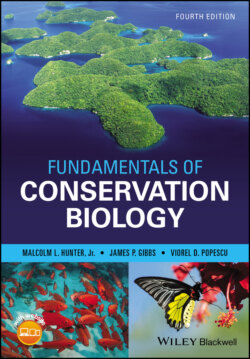Читать книгу Fundamentals of Conservation Biology - Malcolm L. Hunter Jr. - Страница 125
TOPICS FOR DISCUSSION
Оглавление1 How can you tell, by using genetics, what the geographic boundaries of a population are?
2 What can you assume is true about the level of migration between populations that have very different allele frequencies from each other?
3 Could a mutation have no importance in the current environment (i.e. confer no advantage or disadvantage) and then become either deleterious or beneficial later? How?
4 Why might managed translocation (i.e. moving plants or animals from one place to another to increase genetic diversity) create potential genetic problems for wild populations?
5 If a population experiences a loss of genetic diversity, is it doomed to extinction because of its loss of genetic diversity?
6 What is your opinion on application of genetic engineering methods as an approach for eliminating populations of invasive species? Or its role in resurrecting extinct species, as is currently being attempted for the wooly mammoth and thylacine (Tasmanian wolf)?LocusIndividual123 1aaBBCC2aaBbCC3AaBBCC4aaBbCC5AaBBCC6AABBCC7aaBBCC8AABBCC9AABBCC10AaBBCC
7 What are the frequencies of alleles for each locus?
8 What are the frequencies of genotypes for each locus?
9 What is the polymorphism for this population using the 95% criterion (the frequency of the most common allele <95%)?
10 What is the average heterozygosity for this population?
11 What would genotype frequencies be at locus 2 in this population if it were in Hardy–Weinberg equilibrium?
12 If individuals 1–6 were females and individuals 7–10 were males, what would be the effective population size of this population?
13 What portion of the genetic variance of this population would be likely to remain after three generations of random genetic drift? (Use the effective population size calculated in the preceding question.)
Answers
1 Locus 1: a = 0.55, A = 0.45; Locus 2: b = 0.10, B = 0.90; Locus 3: C = 1.00
2 Locus 1: aa = 0.4, AA = 0.3, Aa = 0.3; Locus 2: Bb = 0.2, BB = 0.8; Locus 3: CC = 1
3 0.67 because loci 1 and 2 are polymorphic
4 0.17 (0.3Aa + 0.2Bb)/3 = 0.17
5 bb = 0.01, Bb = 0.18, BB = 0.81
6 9.6: (4 × 6 × 4)/(6 + 4)
7 0.85: [1 − 1/(2 × 9.6)]³
